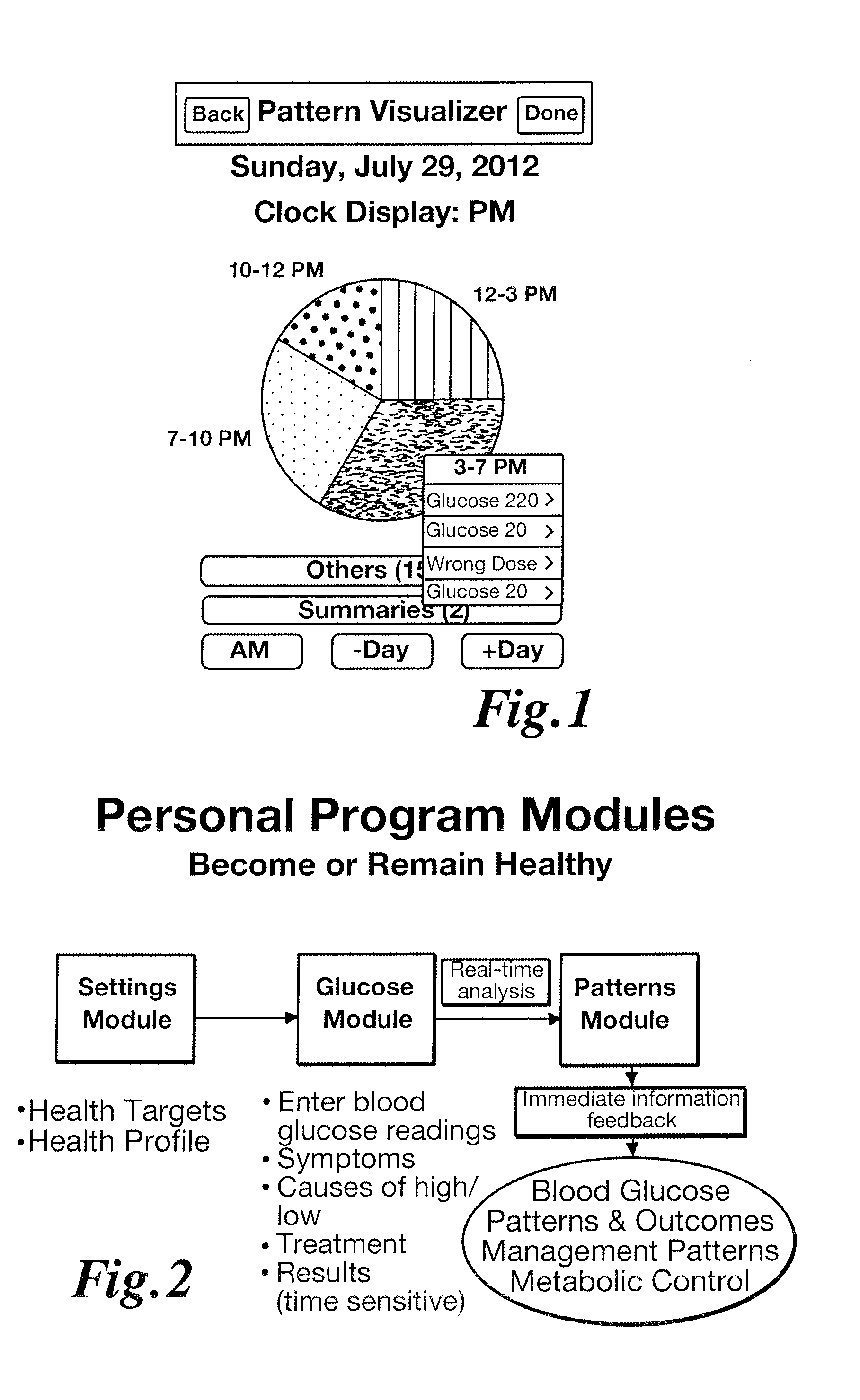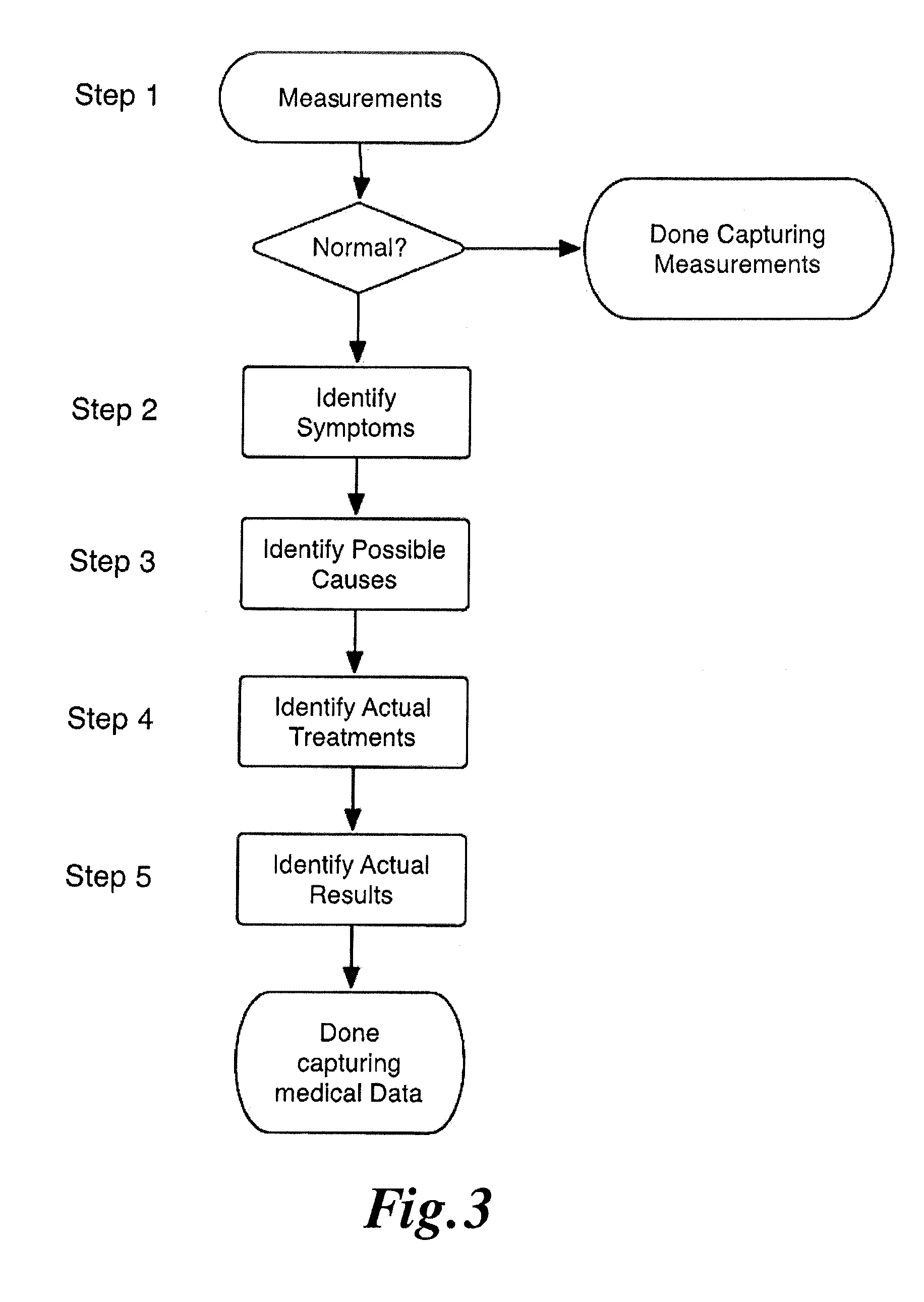Evidence-based personalized, diabetes self-care system and method
a self-care system and personalized technology, applied in the field of evidence-based personalized, diabetes self-care system and method, can solve the problems of systemic complications and damage to all, achieve personal best health outcomes, improve self-control, and improve self-care. the effect of self-car
- Summary
- Abstract
- Description
- Claims
- Application Information
AI Technical Summary
Benefits of technology
Problems solved by technology
Method used
Image
Examples
experiment # 1
Experiment #1
[0111]Blood glucose readings were taken at discrete intervals (e.g., by finger pricks). Carbohydrates, bolus insulin, and basal insulin were administered at the times shown in Table 1. The patient exercised moderately for the duration shown in Table 1. The pigtail effect (i.e., duration of effect) of exercise was set to “moderate” (2 hours).
TABLE 1Meter BGBolusCarbsBasal(finger prick)ExercisePigtail effectTargets41:00 AM508:00 AM178:00 AM2031:00 AM1:15 PM2:15 AMModerate2 hoursLowHigh188:00 AM8011:45 AM 188:30 PM3318:00 AM70801511:45 AM 908:30 PM21511:45 AM 258:30 PM1182:30 PM3818:30 PM16610:30 PM
[0112]A first representation of a relationship graph from the data in Table 1 is depicted in FIG. 8.
[0113]The bottom line 10 represents the date and time line. The small squares 12 represent the blood glucose measurement. The horizontal lines 14 (pigtails) associated with carbs, bolus and basal medication doses represent the time of effectiveness, which is assumed to be linear....
experiment # 2
Experiment #2
[0123]Blood glucose readings were taken continuously using a Medtronic Solutions Continuous Glucose Monitoring System (CGMS) iPro Model 2.0A. Finger pricks were taken at discrete intervals to calibrate the CGMS. FIG. 9 shows a representation of a relationship graph from the results.
[0124]The small squares 12 represent these discrete calibration measurements. Output 22 from the CGMS is overlaid on the graph. The data for carbs, bolus insulin, and basal insulin is the same as in Table 1. The patient exercised moderately for the duration shown in Table 1.
[0125]Table 2 shows the values of blood glucose from the CGMS.
TABLE 2Continuous Glucose Data12:15 AM12:30 AM12:45 AM1:00 AM1:15 AM1:30 AM1:45 AM2:00 AM 72 731051391501571851872:15 AM2:30 AM2:45 AM3:00 PM3:15 AM3:30 AM3:45 AM4:00 AM2002052172422522822782854:15 AM4:30 AM4:45 AM5:00 AM5:15 AM5:30 AM5:45 AM6:00 AM2952782853002952982953006:15 AM6:30 AM6:45 AM7:00 AM7:15 AM7:30 AM7:45 AM8:00 AM2812802802922782723003038:15 AM8:30...
experiment # 3
Experiment #3
[0126]Blood glucose readings were taken at discrete intervals (e.g., by finger pricks). Carbohydrates, bolus insulin, and basal insulin were administered at the times shown in Table 1. The patient exercised moderately for the duration shown in Table 1. FIG. 10 shows a representation of a relationship graph from the results. Unlike Experiments 1 and 2, the time of administration and duration of effect of carbohydrates and bolus insulin is calculated from generally accepted parameters and shown 24 as variable over time. The amount of carbohydrates, bolus insulin, and basal insulin is the same as Table 1.
PUM
 Login to View More
Login to View More Abstract
Description
Claims
Application Information
 Login to View More
Login to View More - R&D
- Intellectual Property
- Life Sciences
- Materials
- Tech Scout
- Unparalleled Data Quality
- Higher Quality Content
- 60% Fewer Hallucinations
Browse by: Latest US Patents, China's latest patents, Technical Efficacy Thesaurus, Application Domain, Technology Topic, Popular Technical Reports.
© 2025 PatSnap. All rights reserved.Legal|Privacy policy|Modern Slavery Act Transparency Statement|Sitemap|About US| Contact US: help@patsnap.com



